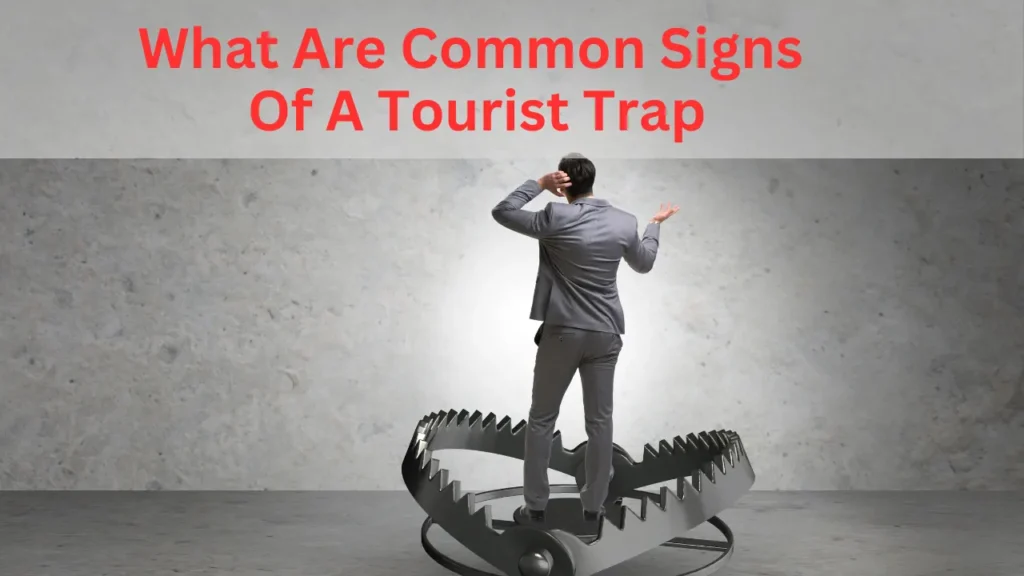What Are Common Signs Of A Tourist Trap? Common signs of a tourist trap include overly aggressive sales tactics and inflated prices. These places often lack local authenticity and target uninformed visitors.
Tourist traps can quickly turn an exciting vacation sour. They are notorious for promising unique cultural experiences but deliver generic, overpriced, and often subpar goods and services. These spots usually boast strategic locations, often near famous attractions, enticing travelers with convenience and hard-to-resist marketing.
High customer turnover rather than satisfied repeat business is a hallmark, typically accompanied by pushy souvenir vendors and multilingual menus serving unremarkable cuisine at hefty premiums. Entering such an establishment, one might notice a distinct
absence of locals—a clear indicator that the establishment caters to out-of-towners looking to capture the essence of a place, often missing the mark by miles. Spotting these signs can save you from the disappointment and financial regret that shadow the unwitting tourist in a trap.

Table of Contents
Toggle- Spotting A Tourist Trap
- High-pressure Sales Tactics
- What Are Signs Of Inauthentic Experiences
- Recognizing Overpriced Services
- Tourist Trap Marketing Tricks
- Navigating Crowded Destinations
- Excessive Photo Opportunities
- Reviews And Word Of Mouth
- Escape The Tourist Trap
- Frequently Asked Questions Of What Are Common Signs Of A Tourist Trap
- Conclusion
Spotting A Tourist Trap
Recognizing tourist traps can be critical to ensuring an authentic travel experience and avoiding unnecessary expenses. A clear indicator of a tourist trap is the presence of overpriced restaurants and gift shops, often situated close to major attractions. Visitors should watch for menus in multiple languages, which typically cater to a tourist crowd.
Another tell-tale sign involves large groups of tourists congregating in certain areas, which can imply that these places are designed specifically for visitors rather than locals. Vigilance is advised when encountering aggressive selling tactics, such as street vendors approaching you unsolicited, often selling souvenir items at inflated prices.
Lastly, attractions boasting “authentic” experiences that seem too staged or cost an entry fee that’s disproportionate to the value offered might not present the genuine article. Authentic local culture typically resides off the beaten path – tourists willing to explore are likely to discover more genuine and rewarding experiences.
High-pressure Sales Tactics
Tourist traps often employ high-pressure sales tactics to urge travelers into making purchases. The presence of persistent local vendors is one such indicator, where sellers aggressively promote their products, sometimes following tourists persistently or blocking their path to gain attention.
Another clear sign involves unsolicited offers where locals approach with offers for help or to sell products, even when you have not shown interest. These offers can often come with a sob story or a claim of a ‘special deal’, leveraging guilt or urgency as a persuasion tool.
What Are Signs Of Inauthentic Experiences
Tourists often seek out authentic local experiences, but tourist traps can stand in the way, offering inauthenticity instead. Generic souvenirs that are not locally made are a significant indicator of a tourist trap. Visitors might encounter items mass-produced in other countries, lacking the unique craftsmanship or cultural essence of the place they’re visiting. These souvenirs are typically aimed at those who do not discern or value genuine local produce.
Attractions that lack cultural significance are another telltale sign. These places may have been developed with the primary goal of attracting as many tourists as possible, neglecting the historical or cultural roots of the location. They often lack the narratives or authenticity that genuine cultural sites provide, making them less enriching for those seeking a true cultural experience.
Recognizing Overpriced Services
A crucial indicator of a tourist trap is the price disparity when services are substantially more expensive compared to the local standards of living. Exploring beyond frequented tourist areas can reveal the authentic pricing landscape. For instance, restaurants situated near major attractions may have inflated prices, preying on the assumption that tourists expect to pay more.
Contrastingly, merely a few streets away, one could discover eateries with prices that align with what locals pay – often significantly lower. This economic discrepancy serves as a red flag, suggesting that the establishment caters more to fleeting tourist traffic rather than offering genuine value.
| Tourist Area | Local Area |
|---|---|
| High service charges | Minimal to no extra charges |
| Menu prices noticeably higher | Prices that reflect local living costs |
Tourist Trap Marketing Tricks
Tourist traps often utilize clever marketing strategies to lure unsuspecting travelers. One of the most prevalent techniques is the strategic placement of advertisements in high-traffic areas. Visitors may find these ads at airports, railway stations, or popular landmarks. The purpose is to grab your attention when you’re most likely to make impulse decisions.
Another common tactic is offering promotions that boast significant savings or one-of-a-kind experiences. These deals may include discounted entry fees, exclusive access, or complimentary gifts. Be wary of these offers; they’re designed to create a sense of urgency and can often lead to rushed and regretted decisions. Always research and read reviews to gauge the true value of any promotion.
Navigating Crowded Destinations
Tourist traps often capitalize on peak times, pulling crowds of travelers away from the authentic local scene. To navigate popular destinations smartly, understanding the distinction between peak tourist hours and a local’s schedule is crucial. Early mornings or
late evenings may offer a more genuine experience, as tourist traffic wanes. These times allow for immersion in the everyday life of the locals, away from the orchestrated hustle tailored for tourists.
Identifying the true local scene requires some investigation. Try engaging in conversations with residents to get recommendations on where they eat and relax. Dive into online forums or social media groups dedicated to the locale, often a rich
source of insights about places cherished by locals. A good rule of thumb is to seek out establishments where the language spoken is predominantly the country’s native tongue, signaling lesser tourist influence.
Excessive Photo Opportunities
Spotting the difference between genuine tourist attractions and tourist traps can be challenging. A telltale sign of a tourist trap is the overemphasis on photo opportunities. At authentic destinations, while you may find a few designated spots for taking photos, they are not the primary focus. Conversely, tourist traps often feature an excess of staged photo areas, suggesting a place is more about visuals than experience.
Profit-driven motivations become apparent when you encounter frequent prompts to take photographs, sometimes at a cost. This could manifest as locals dressed in costumes insisting on pictures for a fee or vendors selling photo-related wares aggressively.
These spots prioritize the creation of picture-perfect moments over offering a meaningful engagement with the locality. Consequently, the authentic vibe of a destination may be overshadowed by these commodified photographic experiences.
Reviews And Word Of Mouth
Understanding online ratings and feedback can be pivotal in avoiding tourist traps. Look for patterns in reviews rather than isolated comments. A high number of positive reviews might be promising, but they could also be misleading or fabricated. On the other hand, consistent negative feedback, especially mentioning similar issues, is a red flag. It’s crucial to seek out authentic reviews from credible platforms where possible.
Locals’ recommendations carry significant weight because residents have firsthand experience with the attractions in their area. They can often tell if a place is just a tourist trap or a genuine local gem. Engaging with the community and asking for their favorite spots can provide insight that online ratings simply cannot match. Trusting local knowledge not only helps in finding authentic experiences but also in supporting local businesses and culture.
Escape The Tourist Trap
To escape the tourist trap and have a more authentic travel experience, it’s important to research and plan your journey with a focus on what the locals do. Interacting with residents, seeking out local eateries, and using public transportation can greatly
enhance your understanding and enjoyment of a destination. Steer clear of restaurants with multi-language menus, as these are often designed for tourists and may not offer a genuine taste of local cuisine.
In addition to dining, shopping local markets and stores instead of standard souvenir shops can lead to finding more unique and meaningful mementos. Participating in community events or festivals can also provide a more authentic cultural experience.
Taking the road less traveled by avoiding the main tourist thoroughfares can reveal hidden gems and unexpected delights in a new city. Remember, blending in is about respecting local customs and culture, which can often lead to a more respectful and welcomed interaction with the community.
Frequently Asked Questions Of What Are Common Signs Of A Tourist Trap
What Are Telltale Signs Of A Tourist Trap?
Tourist traps often feature overpriced services, aggressive sales tactics, and exaggerated claims about uniqueness or authenticity. You might notice a prevalence of souvenir shops over local culture-oriented establishments and restaurant menus tailored to foreigners rather than locals.
How Can I Avoid Tourist Traps While Traveling?
Research your destination beforehand and look for recommendations from locals or experienced travelers. Avoid overly crowded and commercialized spots, especially those heavily advertised in tourist areas. Seeking out local eateries and shops usually leads to more authentic experiences.
Are There Benefits To Visiting Tourist Traps?
While generally not offering an authentic local experience, tourist traps can provide convenience, especially for those looking for predictable services and souvenirs. They’re also typically located near major landmarks, which can help when time is limited.
What Impact Do Tourist Traps Have On Local Economies?
Tourist traps often contribute to the local economy by providing jobs and generating tax revenue. However, in some cases, they may favor larger businesses over small local ones and can sometimes lead to the commercialization and loss of authentic local culture.
Conclusion
Being vigilant about tourist traps enhances your travel experience. Remember the red flags: pushy sales tactics, non-local crowds, inflated prices, and gimmicky promotions. Trust your instincts and do your research. A genuine adventure awaits beyond the allure of these pitfalls.
Safe and savvy travels await the informed explorer.


